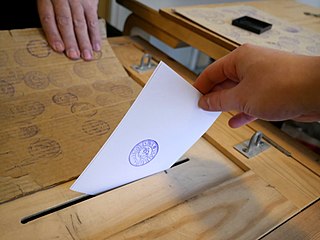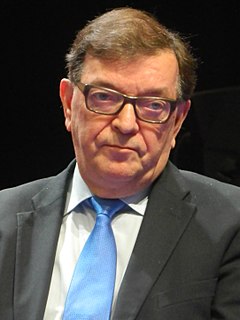| ||
16 seats to the European Parliament | ||
|---|---|---|
The 1996 European Parliament election in Finland was the first election of the Finnish delegation to the European Parliament.
| ||
16 seats to the European Parliament | ||
|---|---|---|
The 1996 European Parliament election in Finland was the first election of the Finnish delegation to the European Parliament.
In 1996, Finland had a population of 5.1 million (4.1 million voters). The government was a broad coalition led by the social democrat Paavo Lipponen. The governing coalition consisted of: the Social Democrats (SDP), The National Coalition Party (Kokoomus), the Left Alliance (Vasemmistoliitto), The Swedish People's Party (RKP) and the Greens (Vihreä liitto). [1]
An asterisk (*) indicates Members standing for re-election.
All Finnish citizens that were 18 years old on the election day at the latest, were eligible to vote. They did not have to register as it was done automatically by the authorities. Other citizens of the European Union who had a domicile in Finland on 30 August 1996 were eligible to vote, although they had to register as voters in Finland and confirm that they did not vote in any other Member State during the elections in 1994 and 1995, and would not vote in Austria in 1996. [1]
According to the Finnish Population Register Center (Väestrekisterikeskus) there were at the end of August 1996 some 72600 foreigners living in Finland. Biggest national groups willing to vote were the Swedes, the Germans and the British. The final date for the registration was 15 August 1996.
In June Väestrekisterikeskus approached with an official letter all the EU nationals living in Finland. The letter was in Finnish, Swedish, English, French and German.
In the European elections candidates could be nominated by the registered political parties and citizens' groups. The parties could do the nomination automatically. The other groups had to gather supporting signatures for each of their candidates from each of the four election districts i.e. each candidate must have had 4 x 1000 supporting signatures. This meant that a non-party organization wanting to nominate the maximum number (16) of candidates had to collect 64000 signatures altogether.
The parties and other groups could choose between two different systems. They could nominate candidates for the whole country or for a region. For the elections Finland was divided into four districts. However, all the parties nominated candidates for the whole country.
The deadline for the parties and other organizations to put forward candidates was 19 September 1996. There were 14 parties and one other organization in the elections. The total number of candidates was 207.
| Party | Votes | % | Seats | |
|---|---|---|---|---|
| Centre Party | 548,041 | 24.36 | 4 | |
| Social Democratic Party | 482,577 | 21.45 | 4 | |
| National Coalition Party | 453,729 | 20.17 | 4 | |
| Left Alliance | 236,490 | 10.51 | 2 | |
| Green League | 170,670 | 7.59 | 1 | |
| Swedish People's Party | 129,425 | 5.75 | 1 | |
| Young Finns | 68,134 | 3.03 | 0 | |
| Christian League | 63,279 | 2.81 | 0 | |
| Alternative to the EU | 47,687 | 2.12 | 0 | |
| Finns Party | 15,004 | 0.67 | 0 | |
| Alliance for Free Finland | 13,746 | 0.61 | 0 | |
| Liberal People's Party | 8,305 | 0.37 | 0 | |
| Finnish Pensioners' Party | 6,357 | 0.28 | 0 | |
| Natural Law Party | 3,327 | 0.15 | 0 | |
| Retirees for the People | 2,640 | 0.12 | 0 | |
| Total | 2,249,411 | 100.00 | 16 | |
| Valid votes | 2,249,411 | 95.05 | ||
| Invalid/blank votes | 117,093 | 4.95 | ||
| Total votes | 2,366,504 | 100.00 | ||
| Registered voters/turnout | 4,108,703 | 57.60 | ||
| Source: Tilastokeskus | ||||
The Green League, shortened to the Greens, is a green political party in Finland.
The Swedish People's Party of Finland is a political party in Finland aiming to represent the interests of the minority Swedish-speaking population of Finland. The party is currently participating in the government of Sanna Marin, holding the positions of Minister of Justice and Minister for Nordic Cooperation and Equality.
The National Coalition Party is a liberal-conservative political party in Finland.

The Left Alliance is a left-wing political party in Finland.
The Centre Party, officially the Centre Party of Finland, is an agrarian political party in Finland.

Patriotic People's Movement was a Finnish nationalist and anti-communist political party. IKL was the successor of the previously banned Lapua Movement. It existed from 1932 to 1944 and had an ideology similar to its predecessor, except that IKL participated in elections, although with limited success.

There are four types of elections in Finland. Each Finnish citizen at least 18 years of age has the right to vote in each of the elections, which decide the following: the president, the parliament, the MEPs, and the municipal and city councils.

Paavo Matti Väyrynen is a Finnish politician and former member of the Finnish Parliament who has represented the Seven Star Movement, the Citizen's Party and Centre Party. He is currently member of Centre Party. Väyrynen has been a member of the Finnish Parliament previously from 1970 to 1995, and again from 2007 to 2011 and has held many ministerial portfolios. He has also been a Member of the European Parliament from 1995 to 2007, and again from 2014 to 2018.

Parliamentary elections were held in Finland on 18 March 2007. Early voting was possible from the 7–13 March. The 200 members of the Eduskunta were elected from 15 constituencies.
The 2009 European Parliament election in Finland was the election of the delegation from Finland to the European Parliament in 2009.

Presidential elections were held in Finland on 16 January 2000, with a second round on 6 February.

Presidential elections were held in Finland on 16 January 1994, with a second round on 6 February. It was the first time the President had been solely and directly elected by a popular vote. Martti Ahtisaari defeated Elisabeth Rehn in the second round.

Parliamentary elections were held in Finland on 17 April 2011 after the termination of the previous parliamentary term. Advance voting, which included voting by Finnish expatriates, was held between 6 and 12 April with a turnout of 31.2%.

Presidential elections were held in Finland in January and February 2012. The first round took place on 22 January 2012 with advance voting between 11 and 17 January. Since no candidate received a majority of the vote, a second round was held on 5 February, with advance voting between 25 and 31 January. Sauli Niinistö was elected the President of Finland for a term from 1 March 2012 until 1 March 2018.

The Social Democratic Party of Finland, shortened to the Social Democrats and commonly known in Finnish as Demarit, is a social-democratic political party in Finland. It is currently the largest party in the Parliament of Finland with 40 seats.

Presidential elections were held in Finland on 28 January 2018. The incumbent Sauli Niinistö received 62.7% of the vote and was elected for a second term, avoiding a second round. The term is from 1 March 2018 to 1 February 2024 (if 2024 presidential election doesn't go to a second ballot) or 1 March 2024. Although the President is elected by direct election, Niinistö gained a plurality in all municipalities and a majority in all but 13 municipalities.
In the run-up to the next Finnish parliamentary election, various organisations will carry out opinion polling to gauge voting intentions in Finland. Results of such polls are displayed in this list.